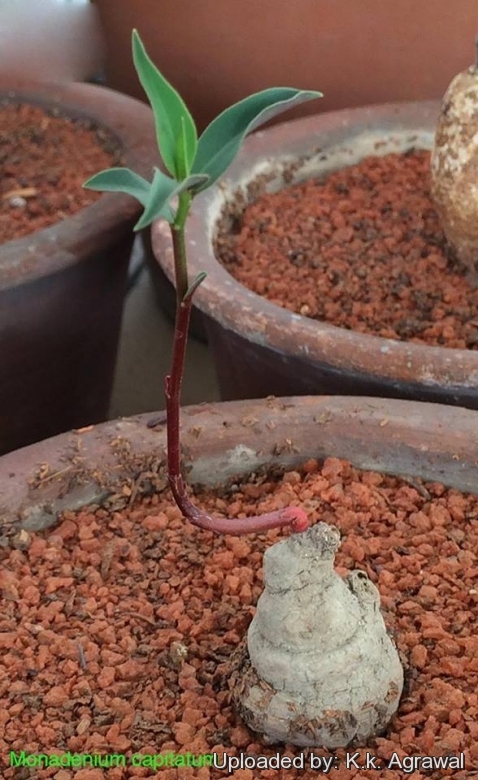Accepted Scientific Name: Euphorbia neocapitata Bruyns
Taxon 55: 413 2006

Monadenium capitatum (Euphorbia neocapitata) Photo by: K.k. Agrawal
Origin and Habitat: Zambia and Central and North-Eastern Tanzania
Altitude range: 1200 - 2200 metres above sea level.
Habitat and ecology: It grows in grassland, deciduous woodland or evergreen thicket on hills and edges of road near woodland in high rainfall miombo. It is usually found growing in the shade of shrubs on gritty sandy soil and/or among granite outcrop. Near Monadenium crispumSN|29612]]SN|29607]] and Monadenium orobanchoidesSN|29607]]SN|29612]].
Synonyms:
See all synonyms of Euphorbia neocapitata
Common Names include:
JAPANESE (日本語): カピターツム
Description: Euphorbia capitata, much better known under its old name Monadenium capitatumSN|29537]]SN|29537]], is a slightly succulent geophytic perennial herb, with a tuberous root, also called a caudex, with fleshy upright annual stems to 60 cm tall topped with interesting leaf. The flowers are yellowish-green or often flushed reddish.
Caudex (rootstock): Tuberous, tapering to 16 cm long by 6 cm in diameter.
Annual stems; Solitary or few, erect, simple, cylindrical 2-4 mm thick or more, minutely papillose, occasionally glabrous, 20–60(90) cm tall, simple or branched only at the base.
Leaves: Subsessile or shortly petiolate, alternate, spirally disposed, 12-16 mm apart, oblanceolate to obovate, 4-13 cm long, 1-4 cm wide, apex acute or mucronate, margins toothed, basal teeth sometimes gland-tipped. Stipules 0.5-1 mm long, glandular.
Inflorences (cymes): Axillary, subsessile, 1- to 2-forked, crowded towards stem tips. Bracts free, slightly shorter than involucre, ± 5 mm long and 4 mm wide, oblong, apex apiculate.
Flowers (cyathia): ± 5 x 3.5 mm, with barrel-shaped involucres. Nectar-gland-rim 1.5-2 mm hight, margin crenulate white or pink. Lobes ± 1.2 × 1.2 mm, rounded, denticulate.
Male flowers: Bracteoles few, ± 1.75 mm long, filamentous, laciniate. Stamens ± 3 mm long.
Female flower: Styles ± 1 mm long, with thickened bifid apices.
Fruits (capsules): Acutely 3-lobed, ± 4.5 x 4 mm, smooth to minutely papillose, exserted on a reflexed pedicel 4 - 5 mm long.
Seeds: Oblong, ± 2.2 x 1.2 mm, pale grey, 4-angled, minutely verrucose/tuberculate, caruncle present ± 1 mm wide, pointed, stipitate, yellow.
Bibliography: Major references and further lectures
1) Urs Eggli “Illustrated Handbook of Succulent Plants: Dicotyledons” Springer Science & Business Media, 2002
2) Susan Carter, A. R. Smith “Flora of Tropical East Africa - Euphorbiaceae” v2 CRC Press, 01/Jun/1988
3) Peter R. O. Bally “The Genus Monadenium: With Descriptions of 21 New Species” Benteli, 1961
4) S. Carter & L.C. Leach “Flora Zambesiaca”, Vol 9 Part 5 2001
5) “Monadenium capitatum” in: African Plants Database (version 3.4.0). Conservatoire et Jardin botaniques de la Ville de Genève and South African National Biodiversity Institute, Pretoria, "Retrieved 25 Oct. 2014", from <http://www.ville-ge.ch/musinfo/bd/cjb/africa/>.
Cultivation and Propagation: Euphorbia capitata (Monadenium capitatumSN|29537]]SN|29537]]) is an interesting addition to a collection, but rarely seen in cultivation. It can be grown outdoors in frost-free climates and forms a small shrub.
Growth rate: It grows well, though very slowly, but it possible to increase the speed of growth to some extent by providing adequate amount of water, warmth, and fertilizer during the active growing season, but it’s susceptible to rotting if too wet.
Exposure: It needs light shade, but the caudex should be in the shade, while the leaves prefer some sun. Avoid direct blasting sun in summer. Bright light if grown indoors.
Soil: In pots it needs a very porous potting medium (add pumice, vulcanite, and perlite). It does better in a rather acidic soil.
Waterings: Water frequently while plant is in full growth, but keep dry during the winter after the branches have died back. It rot easily and do NOT like a lot of water when it has no leaves.
Fertilizer: Benefits from moderate doses of a well-balanced, slow-release fertilizer.
Frost tolerance: Due to its African origin keep warm in winter, the minimum safe average temperature is 15°C, although it can go lower for short periods. It can be grown outdoors in frost-free climates, need anyway to kept above 10°C and dry in winter. It is very prone to rot in cool, wet conditions. USDA Zone 10-12, but does very well in containers.
Manteinance: Repot every two years. It like pots with generous drain holes. In the winter, the branches die back and should be cut back t to encourage branching, to maintain an attractive shape and to ensure caudex habit.
Pest and diseases: White meldew, mould and other fungi.
Propagation: The species can be propagated by both seeds and cuttings. The plants for seed production are generally grown from cuttings since these bloom more freely. The plants for decoration are grown from seed since they develop a caudex.










